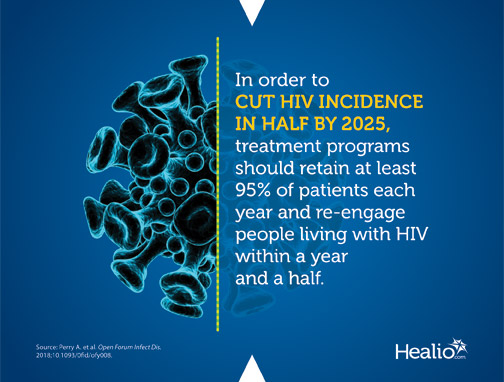Halving HIV incidence in US requires ‘ambitious’ goals, researchers say
To cut HIV incidence in half by 2025, treatment programs need to retain at least 95% of patients each year and re-engage people living with HIV within a year and a half, study data showed.
“There are currently an estimated 1.1 million persons aged 13 [years] and older living with HIV (PLWH) in the United States, with some estimates suggesting that less than 50% are retained in care,” Maunank Shah, MD, PhD, assistant professor at Johns Hopkins University School of Medicine, and colleagues wrote. “Despite improvements in ART and evidence for ‘treatment as prevention’ with guidance for early ART initiation, incidence of HIV has declined at a slow rate and remains between 36,000 to 39,000 new HIV infections per year. Among the challenges is an imperfect HIV care continuum, in which current national estimates suggest that suboptimal numbers of PLWH are virologically suppressed, representing missed opportunities for averting ongoing HIV transmission.”
Among its goals, the U.S. National HIV/AIDS Strategy aims to reduce 25% of new HIV infections by 2020. However, Shah and colleagues said there is a “paucity of useable program-level benchmarks tied to population-level epidemiologic goals.” They sought to define “tangible benchmarks” for annual rates along the HIV care continuum that can result in significant reductions in HIV incidence in the U.S. In a modeling study, they generated approximately 100,000 simulations to determine the annual rates of screening, retention and re-engagement of care, and the percentage of PLWH linked to care that is needed to achieve a 50% reduction in HIV incidence by 2025.
Seven percent of all simulations achieved a 50% reduction in HIV incidence, the researchers reported. Even when the models included high rates of care re-engagement, it was not possible for any simulation to achieve the target incidence if more than 20% of patients disengaged from care. However, when the rate of retention was 95% and PLWH who had disengaged from care re-engaged within a mean of 1.5 years, there was roughly a 90% chance of cutting HIV incidence in half by 2025.
“These goals for retention and re-engagement rates are ambitious, and future research should focus on their feasibility (ie, specific intervention efficacy and costs) and identifying evidence-based effective strategies to achieve such targets, while also emphasizing the need for a comprehensive approach including scale-up of prevention and accounting for potential changes in transmission over the next decade,” the researchers wrote. “As HIV care programs move forward, our model suggests that efforts, resources and priorities must be focused on retaining almost all PLWH in care and frequently re-engaging those out of care to reduce HIV incidence in the U.S. over the next decade.” – by Andy Polhamus
Disclosures: The authors report no relevant financial disclosures.

